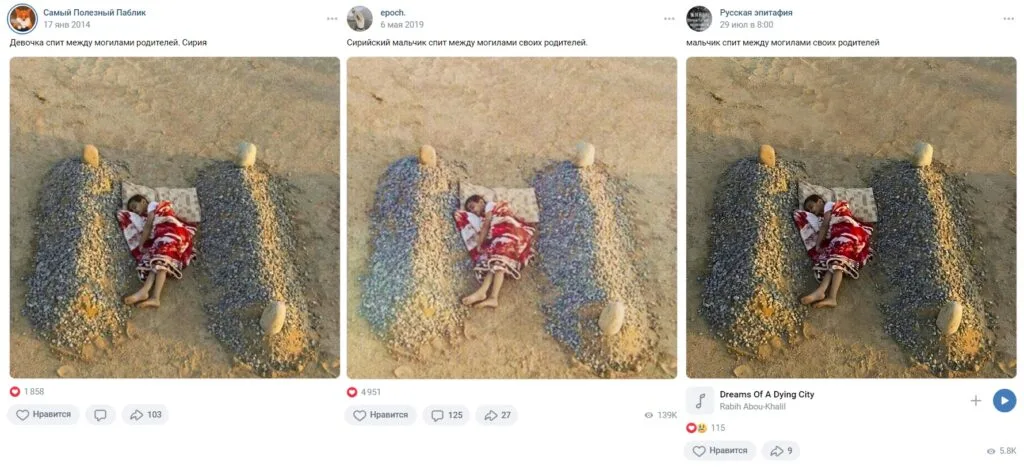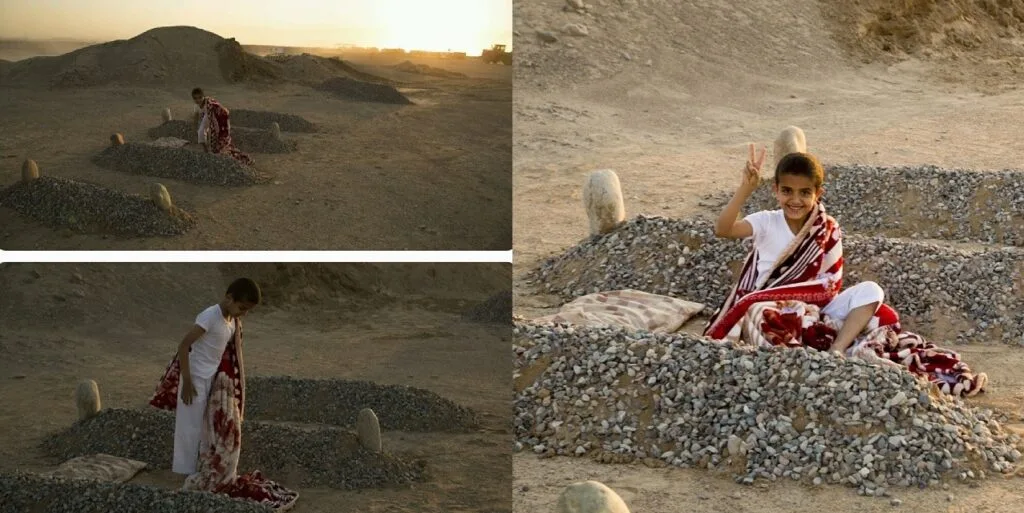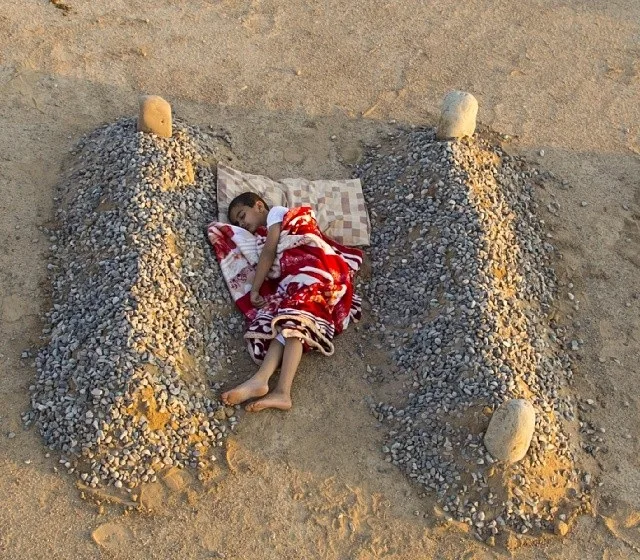For more than 10 years, a photograph has been circulating on the Internet, allegedly depicting a Syrian boy who fell asleep near the graves of his dead mother and father. We have verified the authenticity of this photo.
In Runet, one of the earliest posts with this image appeared on January 17, 2014 on VKontakte in the community “The most useful public"(more than 1800 likes). “The girl sleeps between her parents’ graves. Syria,” reads the caption on that entry, although most other publications claim that the photographer captured a Syrian boy. For example, in 2019 in public epoch such a post received almost 5,000 likes and more than 139,000 views. Similar publications were posted on VKontakte and other platforms (LiveJournal, Facebook*, fotostrana.ru) in 2015, 2016, 2017, 2018 And 2020 years. According to OSINT researcher Tala Khagina, recently Internet users have been claiming that the photo was taken not in Syria, but in Gaza. "Verified" also found publication for July 2024, where the boy’s nationality is not mentioned at all.

In fact, the viral photo has nothing to do with Palestinian-Israeli conflict, neither with civil war in Syria, which media from different countries wrote about back in January 2014.
One of the first investigations on this topic in my blog released Dutch journalist Harald Doornbos, who at that time was in southern Turkey near the border with Syria. He found out that the author of the distributed photo was Saudi Arabian citizen Abdul Aziz al-Otaibi, and together with a translator he called him. “Look, it’s a complete lie that my photo has anything to do with Syria,” the photographer said. “I’m shocked at how people distorted my picture.” “I love photography,” he continued. — Every artist has ideas in his head. Therefore, I had the idea to make a project in which I would show through photos how irreplaceable a child’s love is for his parents. This love cannot be replaced by anything or anyone, even if the parents are dead.”
To realize the planned art project, al-Otaibi went in his car to the outskirts of Yanbu, the city in the west Saudi Arabia. Apparently, this happened at the end of 2013, since, according to him, the trip took place three weeks before January 17, 2014. Not far from Yanbu, the photographer built piles of sand that looked like human graves, covered them with stones and asked his nephew to lie down between them and cover himself with a blanket. “Of course, I would never put a child between two real graves,” he says. “I would be categorically against this.”
At the beginning of January 2014, al-Otaibi first posted on his social networks black and white version of the photo of his “sleeping” nephew. “He did not find a home among the living. He lived between his mother and father... I hope you like the idea. Everyone will understand and write about this photo in their own way,” read signature. In the next post, already with color photography, it was said: “Some children may feel that the bodies of their deceased parents are more tender than the bodies of living ones whose hearts have hardened.” He later posted several pictures of the same child smiling posing and on which visiblethat there were more than two makeshift graves. “I also published the backstage. I just wanted to make sure people didn’t draw the wrong conclusions,” the author explained.

However, the photo still began to spread online with the wrong context. On January 16, 2014, the war in Syria in its tweet This photo was mentioned by a Twitter user (now X) with the username @americanbadu is an Arabic-speaking American influencer, living in Saudi Arabia since 2012. He reportedly had about 187,000 followers at the time, so his post quickly went viral. At the same time, the Dutch journalist notes, al-Otaibi sent @americanbadu several messages in which he asked why the blogger took his photo and wrote about Syria, and also asked to correct the signature. Doornbos quoted the influencer as saying: “Why don’t you just go ahead and say it’s from Syria and get a reward from God? You're exaggerating." However, the blogger soon deleted his tweet. “It’s simply unfair to take one of my photographs out of context like this and use it for your own propaganda,” the photographer complained. Already on January 18, 2014, in his post al-Otaibi thanked many media outlets who also contacted him and told about the real origin of his photo. To beirut.com he stated: “It’s absurd how easily people can be manipulated without going back to the source and the facts.”
Thus, the viral photo was not taken in Syria or Gaza, but in Saudi Arabia. The photo does not show real graves, but piles of sand and stones that imitate them. The supposedly sleeping child captured in the photo is the nephew of the author of this art project, who specifically posed for the camera.
*Russian authorities think Meta Platforms Inc., which owns the social networks Facebook and Instagram, is an extremist organization; its activities in Russia are prohibited.
Cover photo: @azezphoto (Instagram)
- Is it true that this photo shows a hospital patient in Gaza?
- Is it true that the photo of a burned Israeli child was created by a neural network based on a photo of a rescued dog?
- Is it true that the photo shows a slave being prepared for sale in the 19th century USA?
If you find a spelling or grammatical error, please let us know by highlighting the error text and clicking Ctrl+Enter.






